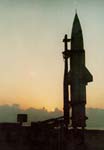|
Prithvi warhead test successful
 The warhead test of the indigenously-developed surface-to-surface missile Prithvi, some of which have reportedly been deployed, was carried out successfully at the interim test range near Balasore recently.
The warhead test of the indigenously-developed surface-to-surface missile Prithvi, some of which have reportedly been deployed, was carried out successfully at the interim test range near Balasore recently.
No TNT was used for the warhead test of the missile, carried out
at Chandipur on Sea near Balasore in Orissa, to ascertain the exact
impact of the bomblets which were dropped from a military
helicopter.
In recent times, no other missile development in any Third World
country has come under such a close scrutiny from the United States
and some other countries as this Indian battlefield support missile.
The Washington Post on Tuesday claimed in a news report attributed to US intelligence officials that India had deployed a
handful of medium range Prithvi missiles at a prospective launch
site near the Pakistani border.
Reacting to the report, a defence ministry spokesman in New Delhi denied any information about the deployment of the Prithvi missiles near Jalandhar.
All formalities having been completed, Prithvi-150 had been
awaiting deployment by the army for quite some time. The Prithvi-250, the longer range Air Force variant of the missile, had also completed its developmental phase successfully and is slated to enter the user trials phase soon. There is also a proposal to develop a naval version of the 8.56 metre-long sleek missile which can carry a payload of upto 500 kg.
The development of the 150-km-range army version of Prithvi
was completed successfully after 16 flight trials. Activities
subsequent to the flight trials had been in progress.
The successful completion of the development phase of
Prithvi-250 placed India in a select band of
countries possessing such sophisticated technologies.
Prithvi is part of the prestigious Integrated Guided Missile
Development Programme under the auspices of the Defence Research and
Development Organisation.
It is also the first weapon system to be ready for
deployment out of the five envisaged under the IGMDP. The others
are Trishul, Akash, Nag and the technology demonstrator Agni.
The Clinton administration has all along been opposed to the
deployment of Prithvi, saying it would trigger an arms race in the sub-continent. It
also fears it may lead to a nuclear war between India and Pakistan.
India rejects all these contentions and points out that the
Indian missile programme would hardly imbalance the existing
military equilibrium in the region, with countries like Iraq, Iran,
Saudi Arabia, China and Pakistan already in possession of a range
of such missile systems.
Some defence experts are of the view that the development of
Prithvi and other missiles under the IGMDP was spurred by the Gulf
war.
According to defence experts, India's case for a missile
programme stems from the fact that ever since Independence it has
been a victim of intrigue and aggression.
Starting with Pakistan's attempt to take Kashmir by force in
1947-48, India has had to face four major wars out of which three
were with Pakistan and one China.
It is also felt that military pressures have not only stunted
India's economic growth and social development, but also diverted a
crucial portion of the country's finances towards military
purchases from foreign sources.
Besides, spiralling costs of military hardware, compounded by a
resource crunch, have forced Indian policy-makers to go in for the
indigenous development of defence systems which include the main
battle tank Arjun, the light combat aircraft and the missiles
under the IGMDP.
The Indian missile programme began nearly 10 years ago when
A P J Abdul Kalam took charge of the DRDO and formed a team
consisting of development, production and user agencies.
Within five years this team achieved great success by
carrying out the first test launch of the Prithvi at Sriharikota on
February 25, 1988.
With a diameter of 1.1 metre, the Prithvi is powered by two liquid propellent rocket engines designed and developed by the DRDO. The regeneratively cooled engines are gimballed to operate independently, making it possible to steer the missile in all three axes using thrust vector control during flight.
The single strap missile uses liquid fuel. The hyperbolic liquid
fuel employs inhibited red fuming nitric acid as an oxidiser and a 50:50 combination of xyligine and triethlyamine as fuel.
The fuel is then filled in propellant tanks made of light
aluminium alloy and completely sealed to facilitate cross country
transportation. The missile can be rapidly deployed from the
vehicle and fired from a single launcher.
Prithvi is guided to its target by a closed loop strapdown guidance
system. The gives the missile hitting its target a circular error probability
of 250 metres.
It has a maximum range of 250 km with a 500 kg warhead, and a reduced range of 150 km with an enhanced 1000 kg warhead.
Its uniqueness lies in the fact that a range of warheads
can be fitted on to the missile, and can be changed under
battlefield conditions.
Warheads developed for the Prithvi include high explosive,
pre-fragmented munition and cluster bomblets, capable of seriously damaging and disabling armour and personnel. Future warheads may
include fuel air explosives.
Among India's immediate neighbours, China is already in
possession of a large arsenal of missiles. Pakistan is understood to
be in possession of Chinese supplied M-11 and indigenous HAFT-I and HAFT-II missiles.
RELATED STORY:
US will 'react very negatively' if India or Pak deploys missiles
|





